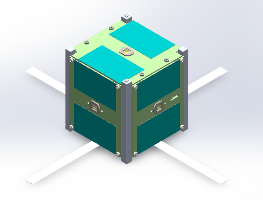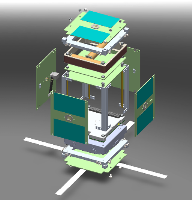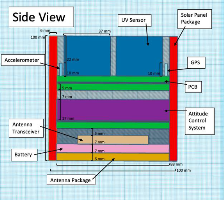| Satellite name | OwlSat |
|---|---|
| Form factor | CubeSat |
| Units or mass | 1U |
| Organisation | Rice University |
| Institution | University |
| Entity type | Academic / Education |
| Nation | US |
| Launch brokerer | NASA CSLI / ELaNa |
| Oneliner |
Analyze the relationship between solar activity and the Earth's lower atmosphere by measuring ultraviolet radiation of the Sun. |
| Description |
Scientific investigation that will analyze the relationship between solar activity and the Earth's lower atmosphere. It will record extreme ultraviolet (EVU) radiation measurements of the Sun, the satellite’s orbital velocity and orbital position to characterize how varying EUV values impact the orbital decay rate. The data will allow for more comprehensive predictions for orbiting bodies, such as space debris and small satellites. Our ground station supports the enhancement of amateur radio as a means of technical self-training for young people by being integrated into Rice University’s amateur radio club. We will provide an exciting activity in which we encourage interest and participation, and support learning of the radio arts by the students. This will provide a means for the OWLSAT team to train amateurs in amateur satellite communication. This will lead to more involvement on and off-campus through training and events. The ground station will be networked to the SATNOGS global database and access system, to allow access to it for all SATNOGS users. Also, Owlsat will measure extreme ultraviolet (EUV) radiation and position, so that students can develop an orbital decay model that considers solar activity.
|
| Sources | [1] [2] [3] [4] |
| Photo sources | [1] [2] |
| COTS subsystems |
|
| Subsystems sources | [1] |
Related Spacecraft
| Satellite | Status | Launcher | Launch date | Orbit |
|---|---|---|---|---|
| ONDOSAT-OWL-1 (OWL-1, OWLSAT-1) | Reentry 2025-01-03. Was operational (Last packets on TinyGS on 2024-12-18, last checked 2024-12-18) | Falcon 9, (Transporter-10) | 2024-03-04 | 510 km, 97.5 deg |
| ONDOSAT-OWL-2 (OWL-2, OWLSAT-2) | Operational (Last packets on TinyGS on 2024-12-18, last checked 2024-12-18) | Falcon 9, (Transporter-10) | 2024-03-04 | 510 km, 97.5 deg |
| ONDOSAT-OWL-3 (OWL-3, OWLSAT-3) | Reentry 2025-01-10? Was operational? (Last TinyGS packets on 2024-12-22, last checked 2024-12-23) | Falcon 9, (Bandwagon-2) | 2024-12-21 | 515 km, 45 deg |
| ONDOSAT-OWL-4 (OWL-4, OWLSAT-4) | Operational? (Last TinyGS packets on 2024-12-23, last checked 2024-12-23) | Falcon 9, (Bandwagon-2) | 2024-12-21 | 515 km, 45 deg |
| ONDOSAT-OWL-5 (OWL-5, OWLSAT-5) | Operational? (Last TinyGS packets on 2024-12-22, last checked 2024-12-23) | Falcon 9, (Bandwagon-2) | 2024-12-21 | 515 km, 45 deg |
| ONDOSAT-OWL-6 (OWL-6, OWLSAT-6) | No signal? (No TinyGS packets found as of 2024-12-31) | Falcon 9, (Bandwagon-2) | 2024-12-21 | 515 km, 45 deg |
| ONDOSAT-OWL-7 (OWL-7, OWLSAT-7) | Operational? (Last TinyGS packets on 2024-12-23, last checked 2024-12-23) | Falcon 9, (Bandwagon-2) | 2024-12-21 | 515 km, 45 deg |
| ONDOSAT-OWL-8 (OWL-8, OWLSAT-8) | No signal? (No TinyGS packets found as of 2024-12-31) | Falcon 9, (Bandwagon-2) | 2024-12-21 | 515 km, 45 deg |
| ONDOSAT-OWL-9 (OWL-9, OWLSAT-9) | Operational? (Last TinyGS packets on 2024-12-22, last checked 2024-12-23) | Falcon 9, (Bandwagon-2) | 2024-12-21 | 515 km, 45 deg |
| ONDOSAT-OWL-10 (OWL-10, OWLSAT-10) | Operational? (Last TinyGS packets on 2024-12-23, last checked 2024-12-23) | Falcon 9, (Bandwagon-2) | 2024-12-21 | 515 km, 45 deg |
| ONDOSAT-OWL-11 (OWL-11, OWLSAT-11) | No signal? (No TinyGS packets found as of 2024-12-31) | Falcon 9, (Bandwagon-2) | 2024-12-21 | 515 km, 45 deg |
| ONDOSAT-OWL-12 (OWL-12, OWLSAT-12) | No signal? (No TinyGS packets found as of 2024-12-31) | Falcon 9, (Bandwagon-2) | 2024-12-21 | 515 km, 45 deg |
| OwlSat | not launched | Firefly Alpha | 2025-12-30 | not launched |
Last modified: 2025-04-23



